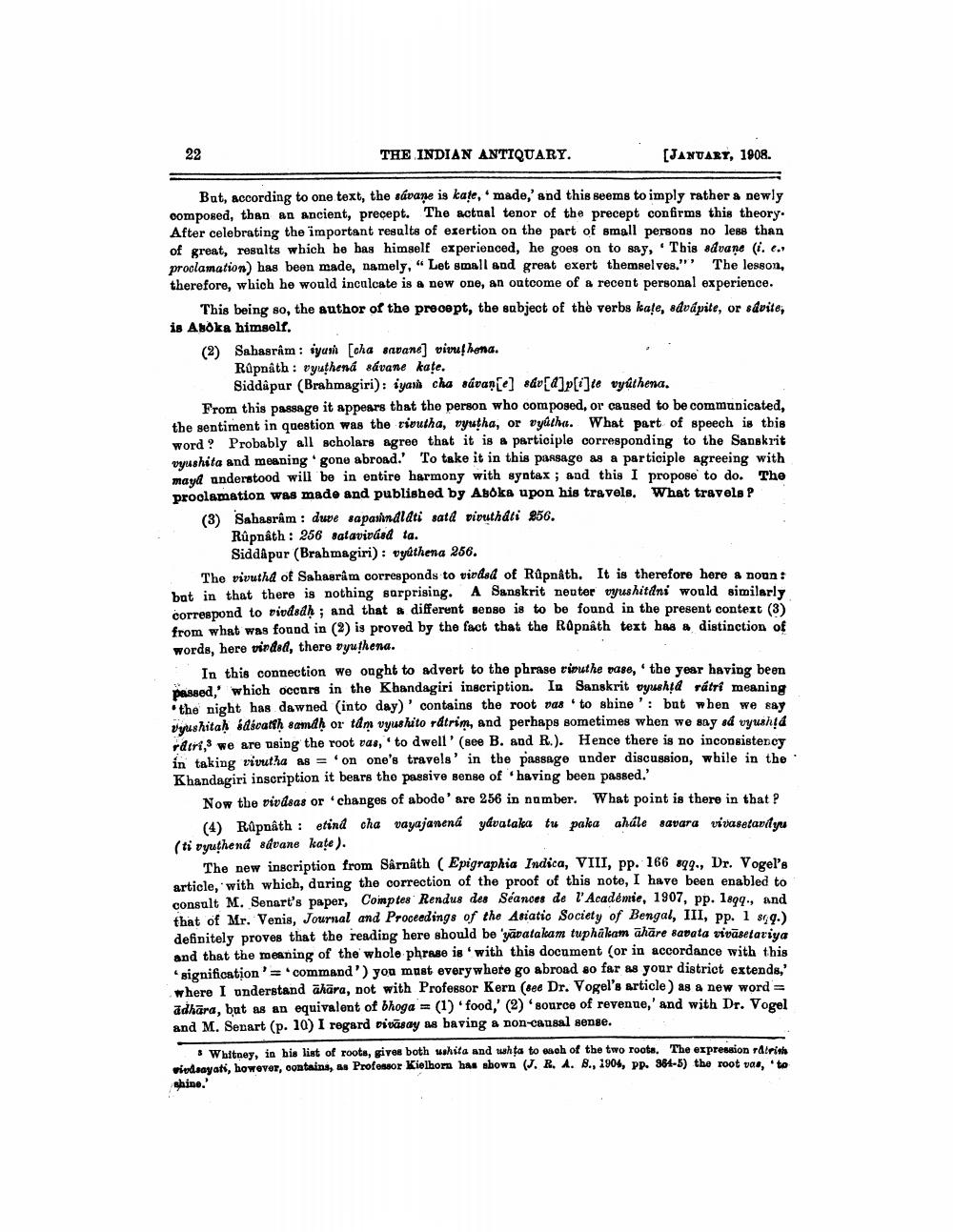________________
22
THE INDIAN ANTIQUARY.
[JANUARY, 1908.
But, according to one text, the savane is kate, made,' and this seems to imply rather a newly composed, than an ancient, precept. The actual tenor of the precept confirms this theory. After celebrating the important results of exertion on the part of small persons no less than of great, results which he has himself experienced, he goes on to say, This savane (i. e. proclamation) has been made, namely, "Let small and great exert themselves." The lesson, therefore, which he would inculcate is a new one, an outcome of a recent personal experience.
6
4
This being so, the author of the precept, the subject of the verbs kate, savápite, or savite, is Asoka himself.
(2) Sahasrâm: iyush [cha savane] vivuthena.
Rupnâth: vyuthená sávane kate.
Siddapur (Brahmagiri): iya cha sávan[e] sáv[a]p[i]te vyûthena.
From this passage it appears that the person who composed, or caused to be communicated, the sentiment in question was the rivutha, vyutha, or vyatha. What part of speech is this word? Probably all scholars agree that it is a participle corresponding to the Sanskrit vyushita and meaning gone abroad. To take it in this passage as a participle agreeing with may understood will be in entire harmony with syntax; and this I propose to do. The proclamation was made and published by Asoka upon his travels. What travels P
(3) Sahasrâm: duve sapasinalati sata vivutháti 256.
Rûpnâth: 256 satavivásd ta.
Siddapur (Brahmagiri): vyûthena 256.
The vivutha of Sahasrâm corresponds to virdad of Rûpnâth. It is therefore here a noun: bat in that there is nothing surprising. A Sanskrit neuter vyushitani would similarly correspond to vivasdh; and that a different sense is to be found in the present context (3) from what was found in (2) is proved by the fact that the Rûpnâth text has a distinction of words, here virded, there vyuthena.
In this connection we ought to advert to the phrase vivuthe vase, the year having been passed, which occurs in the Khandagiri inscription. In Sanskrit vyushta rátri meaning the night has dawned (into day)' contains the root vas to shine but when we say vyushitaḥ sasvattḥ samdḥ or tam vyushito rátrim, and perhaps sometimes when we say ad vyushid ratri, we are using the root vas, to dwell' (see B. and R.). Hence there is no inconsistency in taking vivutha as on one's travels' in the passage under discussion, while in the Khandagiri inscription it bears the passive sense of having been passed.'
Now the vivasas or changes of abode' are 256 in number. What point is there in that?
(4) Rûpnâth: etind cha vayajanená yávataka tu paka ahale savara vivasetarilyu (ti vyuthend savane kate).
The new inscription from Sârnâth (Epigraphia Indica, VIII, pp. 166 sqq., Dr. Vogel's article, with which, during the correction of the proof of this note, I have been enabled to consult M. Senart's paper, Comptes Rendus des Séances de l'Académie, 1907, pp. 18qq., and that of Mr. Venis, Journal and Proceedings of the Asiatic Society of Bengal, III, pp. 1 sqq.) definitely proves that the reading here should be 'yavatakam tuphākam āhāre savata viväsetaviya and that the meaning of the whole phrase is with this document (or in accordance with this 'signification' 'command') you must everywhere go abroad so far as your district extends," where I understand ahara, not with Professor Kern (see Dr. Vogel's article) as a new word= adhara, but as an equivalent of bhoga (1) 'food,' (2) 'source of revenue,' and with Dr. Vogel and M. Senart (p. 10) I regard vivasay as baving a non-causal sense.
s Whitney, in his list of roots, gives both ushita and ushta to each of the two roots. The expression ratrish vivasayati, however, contains, as Professor Kielhorn has shown (J. R. A. B., 1904, pp. 384-5) the root vas, to shine.'




